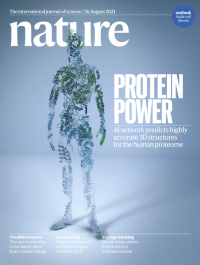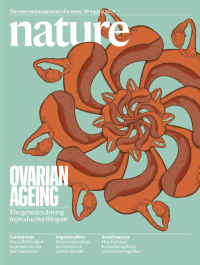Volume 596
-
No. 7873 26 August 2021
Protein powerProteins are essential to life, and understanding their 3D structure is key to unpicking their function. To date, only 17% of the human proteome is covered by an experimentally determined structure. Two papers in this week’s issue dramatically expand our structural understanding of proteins. Researchers at DeepMind, Google’s London-based sister company, present the latest version of their AlphaFold neural network. Using an entirely new architecture informed by intuitions about protein physics and geometry, it makes highly accurate structure predictions, and was recognized at the 14th Critical Assessment of Techniques for Protein Structure Prediction last December as a solution to the long-standing problem of protein-structure prediction. The team applied AlphaFold to 20,296 proteins, representing 98.5% of the human proteome. The predictions have been made freely available in partnership with the European Bioinformatics Institute, along with additional predictions for long human proteins and for 20 other model organisms.
Nature Outlook
-
No. 7872 19 August 2021
Ovarian ageingReproductive lifespan varies considerably in women and its timing impacts fertility and healthy ageing. Natural fertility declines 5-10 years prior to the menopause, which occurs between the ages of 40 and 60 in most women. In this week’s issue, an international team of scientists sheds light on the genetics behind this process. The researchers analysed genetic data from 201,323 women and identified 290 genetic determinants associated with menopause timing. When they manipulated two of these genes — Chek1 and Chek2 — in mice, the team found that they directly affected fertility and reproductive lifespan. The researchers hope that the results might offer therapeutic routes to extend fertility and prevent disease.
-
No. 7871 12 August 2021
Seen in solutionA number of optical techniques allow researchers to view individual molecules in chemical reactions, but effective imaging of single-molecule reactions in solution remains a challenge. In this week’s issue, Jiandong Feng and his colleagues report direct imaging of single-molecule electrochemical reactions in solution and show that the technique can be used for super-resolution microscopy. The researchers make use of a luminescent molecule that emits a photon when it is excited by chemical reactions. By ensuring that the molecule’s reaction position is spatiotemporally isolated in solution, it is possible to pinpoint the electrochemiluminescence that occurs when a single luminescent molecule becomes excited. Over time, this can build up a picture of the electrode, which the team uses to image a single cell. The researchers show their technique can be used to image cell adhesions at nanometre resolution without needing an external light source.
-
No. 7870 5 August 2021
High and risingFlooding affects more people than any other environmental hazard — and the risk of floods is growing. In this week’s issue, Beth Tellman and her colleagues reveal the extent of rising flood exposure by combining satellite images with population data to develop the Global Flood Database. Covering 913 large floods between 2000 and 2018, the database uses 12,719 daily satellite images with a resolution of 250 metres. The researchers found that between 250 million and 290 million people were directly affected by the floods and that the proportion of population residing in flood-affected areas grew by nearly one-quarter in the period 2000 to 2015. Climate-change projections suggest this proportion will rise still further by 2030, with at least 57 countries expected to see substantial increases in the percentage of their population exposed to floods — as illustrated by the floods in China this year (pictured). The team suggests that the flood database could help inform planning and adaptation strategies to mitigate potential future problems.




